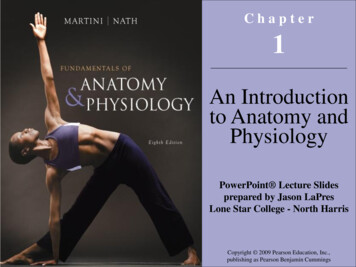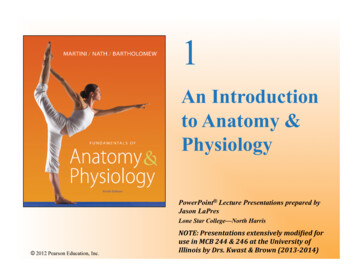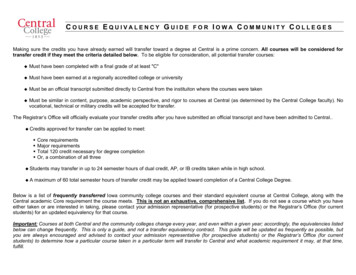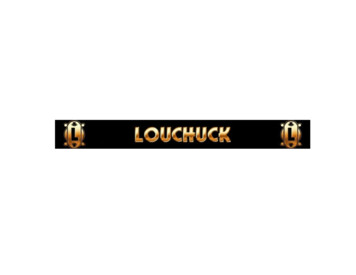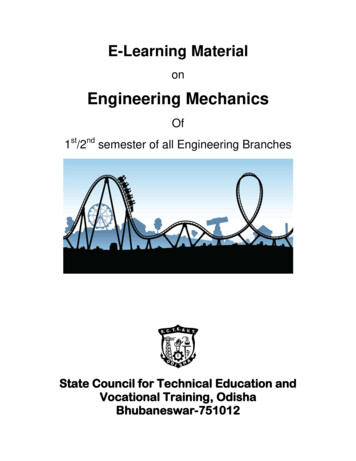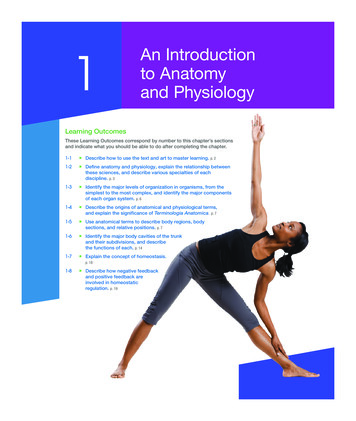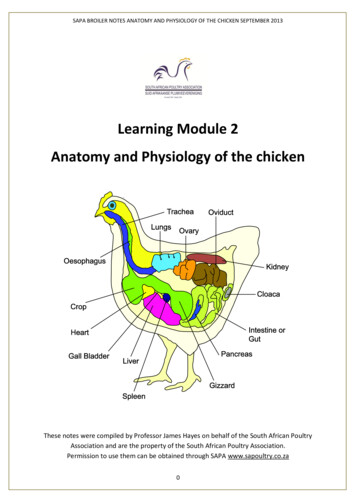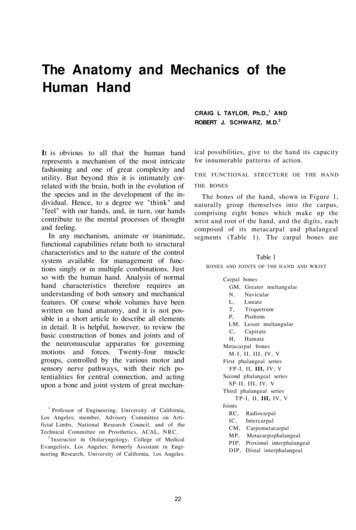
Transcription
The Anatomy and Mechanics of theHuman HandCRAIG L TAYLOR, Ph.D.,1 ANDROBERT J. SCHWARZ, M.D.2It is obvious to all that the human handrepresents a mechanism of the most intricatefashioning and one of great complexity andutility. But beyond this it is intimately correlated with the brain, both in the evolution ofthe species and in the development of the individual. Hence, to a degree we "think" and"feel" with our hands, and, in turn, our handscontribute to the mental processes of thoughtand feeling.In any mechanism, animate or inanimate,functional capabilities relate both to structuralcharacteristics and to the nature of the controlsystem available for management of functions singly or in multiple combinations. Justso with the human hand. Analysis of normalhand characteristics therefore requires anunderstanding of both sensory and mechanicalfeatures. Of course whole volumes have beenwritten on hand anatomy, and it is not possible in a short article to describe all elementsin detail. It is helpful, however, to review thebasic construction of bones and joints and ofthe neuromuscular apparatus for governingmotions and forces. Twenty-four musclegroups, controlled by the various motor andsensory nerve pathways, with their rich potentialities for central connection, and actingupon a bone and joint system of great mechan1Professor of Engineering, University of California,Los Angeles; member, Advisory Committee on Artificial Limbs, National Research Council, and of theTechnical Committee on Prosthetics, ACAL, N R C .2Instructor in Otolaryngology, College of MedicalEvangelists, Los Angeles; formerly Assistant in Engineering Research, University of California, l.os Angeles.22ical possibilities, give to the hand its capacityfor innumerable patterns of action.T H E FUNCTIONAL STRUCTURE OE THE H A N DTHE BONESThe bones of the hand, shown in Figure 1,naturally group themselves into the carpus,comprising eight bones which make up thewrist and root of the hand, and the digits, eachcomposed of its metacarpal and phalangealsegments (Table 1). The carpal bones areTable 1BONES AND JOINTS OF THE HAND AND WRISTCarpal bonesGM, Greater rmLM, Lesser multangularC,CapitateH,HamateMetacarpal bonesM - I , II, III, IV, VFirst phalangeal seriesFP-I, II, III, IV, VSecond phalangeal seriesSP-II, III, IV, VThird phalangeal seriesTP-I, II, III, IV, VJointsRC, RadiocarpalIC,IntercarpalCM, CarpometacarpalMP, MetacarpophalangealPIP, Proximal interphalangealDIP, Distal interphalangeal
23Fig. 1. Bones and articulations of thehand, including the interosseus muscles. A,volar view; B, dorsal view. For nomenclature, see Tables 1 and 2.Fig. 2. Angles of rotation about the wrist. A, extension (or dorsiflexion); B, flexion (or volar flexion); C, radialflexion; D, ulnar flexion.
24TAYLOR AND SCHWARZarranged in two rows, those in the more proximalrow articulating with radius and ulna. Between the two is the intercarpal articulation.The bony conformation and ligamentous attachments are such as to prevent both lateraland dorsal-volar translations but to allow participation in the major wrist motions (Fig. 2).In each of the digits, the anatomical designis essentially the same, with exceptions in thethumb. Metacarpals II through V articulateso closely with the adjacent carpal bones of thedistal row that, although they are capable ofsome flexion and extension, independence ofmotion is very limited. The metacarpal shaftsare arched to form the palm, and the distalends are almost hemispherical to receive theconcave curvature of the proximal ends of thefirst phalanges.The metacarpophalangeal joint exhibits apattern seen also in the interphalangeal joints.As shown schematically in Figure 3, the virtual center of rotation lies approximately atthe center of curvature of the distal end of theproximal member. The lateral aspects of thejoint surfaces are narrowed and closely boundwith ligaments, so that lateral rotation issmall in the metacarpophalangeal joints andlacking entirely in the phalangeal articulations. Hence, the latter are typical hingejoints. The thumb differs from the other digitsfirst in that the second phalanx is missing and,second, in that there is greater mobility in thecarpometacarpal articulation.(Table 2) lie in the forearm and, narrowinginto tendons, traverse the wrist to reach insertions in the bony or ligamentous components of the hand. Generally, the flexors(Fig. 4) arise from the medial epicondyle ofMUSCLES AND TENDONSthe humerus, or from adjacent and volar asMost of the muscles of hand and wrist pects of the radius and ulna, and then coursedown the inside of the forearm. They are, therefore, inpart supinators of the forearm(Fig.5).The extensors (Fig.6)of wrist and digits originatefrom the lateral epicondyleand parts of the ulna, passdown the dorsal side of theforearm, and thus assist inpronation. The thumb sharesin the general flexor-extensorFig. 3. Section through radius, lunate, capitate, and the bony structurescheme, but its extensors andof digit III, showing virtual centers of rotation of each segment upon theabductors originate from midnext more proximal one. When the fist is clenched, the prominence of theand distal parts of radius andknuckles is formed by the head of the more proximal member of each articuulna.lation. For nomenclature, see Table 1.
25Fig. 4. Flexors of wrist and digits. For nomenclature, see Table 2.The tendons of wrist and hand pass throughbony and ligamentous guide systems, as shownschematically in Figure 7. Flexor tendons passthrough a "tunnel" bounded dorsally by carpalbones, laterally by the greater multangular andthe projection of the hamate, and volarly bythe tough transverse carpal ligament. Similarly, the dorsal carpal ligament guides theextensor tendons, and a system of sheathsserves as a guide for flexor and extensor tendonsthrough the metacarpal and phalangealregions.The intrinsic muscles of the hand, i.e.,those with both origin and insertion confinedto wrist and hand (Fig. 8), are, with the exception of the abductors of thumb and littlefinger, specialized for the adduction of thedigits and for opposition patterns such asmaking a fist, spherical grasp, and so on.THE PALMAR AND DIGITAL PADSThe volar aspect of the palm and digits iscovered with copious subcutaneous fat and arelatively thick skin so designed in a series offolds that it is capable of bending in prehension. The folds are disposed in such a way asto make for security of grasp, while the underlying fat furnishes padding for greater firmnessin holding. Because, however, slipping of theskin over the subcutaneous fat would lead toinsecure prehension, the folds are tightly bounddown to the skeletal elements, much as mat-
26tresses and upholstered furniture are quiltedor otherwise fastened to prevent slippage ofthe filler.In the hand, the volar skin is tied down bywhite fibrillar tissue connecting the sheaths ofthe flexor tendons to the deep layer of thedermis along the lateral and lower edges of thepalmar fascia. The folds therefore vary withthe relative lengthsof the metacarpalbones and with themutual relations ofthe sheaths of thetendons andtheedge of the palmarfascia.The sulci, or furrows, are emphasizedbecause the subcutaneous fat in anygiven area is restricted to the interval between the linesalong which the skinis tied down. Thuspressure upon anyindividual monticuluscannot displace the underlyingsoft tissue beyondthe boundaries established by thefibrillar connections.The relative size ofany particular eminence is an indication of the size ofFig. 5. Forearm design asthe muscle involvedrelated to hand mobility.and of its relaBy virtue of this arrangement, the hand can be rotive d e v e l o p m e n ttated through 180 deg.,through usage, withpalm up to palm down,the exception thatwith the elbow flexed. Withthesize of the hythe arm fully extended,participation of shoulderpothenar eminenceand elbow allows the handdepends in part uponto be rotated through althe prominence ofmost 360 deg., palm up topalm up. U, ulna; R, radius;the pisiform.P, pronation; S, supination.THE DORSAL INTEGUMENTUnlike the volar surface, the dorsal side ofthe hand is covered with thin, soft, pliableskin and equally mobile subcutaneous tissue,both capable of yielding easily under tension.Because in flexion of the fingers and in makinga fist the covering on the back of the hand mustbe able to stretch from wrist to fingernails, thedorsal skin is arranged in numerous minuteredundancies, which, in the fiat-of-hand, aremanifest in the typical transverse wrinkles,particularly over the phalangeal articulations.Special adaptations in the dorsal skin of thethumb accommodate the distinctive rotational planes of that digit about its carpometacarpal articulation. In the normal, healthyhand, the degree of redundancy in any givenarea is just such that all wrinkles are dispatched when the fist is clenched. Swelling inany area, dorsal or volar, inhibits flexionextension of the part affected.NERVE AND BLOOD SUPPLYThree principal nerves serve the muscles ofthe hand (Fig. 9). Nerve supply is indicated,except for minor variations and exceptions, inTable 3. Each of these major nerve trunksdiverges into countless smaller branches endingin the papillae of the palmar pads and dorsalskin, and the whole neuromuscular system isso coordinated in the brain that motor response to stimuli is ordinarily subconscious andreflex. Thus an object slipping from the graspis automatically gripped more firmly, but notso firmly as to damage the hand itself. Noxiousstimuli are rejected automatically, as when
27Fig. 6. Extensors of wrist and digits. For nomenclature, see Table 2.the fingers are withdrawn from an object uncomfortably hot.The wrist and hand receive their blood supply from the radial and ulnar arteries, whichrun parallel with the bones concerned, enterthe hand through the flexor "tunnel," andthen join through a double-arch system (Fig.10). Small branches from the arches serve thedigits. The major venous system comprisesthe basilic and cephalic veins superficiallyplaced on the volar surface of the forearm.T H E RESTING H A N D PATTERNThe resting hand assumes a characteristicposture, a feature easily seen when the handhangs loosely at the side. The resting wristtakes a mid-position in which, with respect tothe extended forearm axis, it is dorsiflexed35 deg. (Fig. 11). It is worth noting that thisis the position of greatest prehensile force(Fig. 12, bottom). The mid-position for radialor ulnar flexion appears to be such that themetacarpophalangeal joint center of digit I I Ilies in the extended sagittal plane of the wrist(Fig. 11).Typically, the conformation of fingers andthumb is similar to that shown for palmar prehension (Fig. 13), the fingers being more andmore flexed from index to little finger. The relations between thumb, palm, and fingers aresuch as to permit grasp of a 1.75-in. cylindercrossing the palm at about 45 deg. to theradioulnar axis. Bunnell (4) considers this "anancestral position ready for grasping limbs,weapons, or other creatures."
28Fig. 7. The anatomy of prehension. Schematic sectionsthrough digits I and III show essential relations of muscles andbones. The letters LG indicate thepresence of ligamentous guideswhich channel close to the wristthe tendons of muscles originating in the forearm. Guide lineX—X indicates relative positionof carpal bases of thumb and fingers. For rest of nomenclature, seeTables 1 and 2. From Taylor (12).FIXED HAND ADAPTATIONSIn thrusting or striking actions and the like,the hand may assume fixed and rigid postureswhile functioning with the arm in support.These represent nonspecialized functions inwhich the hand serves merely as an adapted"end of the arm." The various forms includethe flat-of-hand, the clenched fist, the knuckleand digital support postures, and so on.tating about a fixed center, as implied in diagrams such as Figure 2, can be justified onlyas a convenient approximation.The muscles traversing the wrist includethose inserting into the carpus and metacarpusand those mediating flexion and extension ofWRIST MECHANICSThe wrist joint, composed of the radiocarpaland intercarpal articulations (Fig. 1), has anelliptical rotation field with the major axis inthe dorsal-volar excursion, the minor in theulnar-radial. No significant torsion occurs.Bunnell (4) gives the angular excursions aboutthe radiocarpal and intercarpal articulation asshown in Table 4.The rotation within the carpal bones duringthese movements is too complicated for brieftreatment. Not only do the rotations occurat several articulating surfaces, but the virtualaxes of rotation lie distal to the contact surfaces owing to gliding motions in the convexconcave structure of the joints. Idealization ofthe motions into those of a simple lever, ro-Fig. 8. Volar intrinsic muscles of the hand. Fornomenclature, see Table 2.
29the phalanges. The latter contribute to thewrist action, particularly under loads. In suchcases, the finger muscles develop reactionagainst the object held (or within the handitself if the fist is clenched) and add their forcesto wrist action. The forces, action, and grouping of these muscles are given in Table 5.photographic observation of the prehensionpatterns naturally assumed by individualswhen (a) picking up and (b) holding for useTable 4ANGULAR EXTENT OF WRIST FLEXIONS"PREHENSION PATTERNSIt is evident equally from a study of themuscle-bone-joint anatomy and from observation of the postures and motions of the handthat an infinite variety of prehension patternsis possible. For purposes of analysis, however,it suffices to describe the principal types.Seeking a logical basis for defining the majorprehension patterns, Keller et al. (9) foundthat the object-contact pattern furnishes asatisfactory basis for classification. FromFig. 9. Nerves supplying the hand. Top to bottom, ulnar nerve, median nerve, radial nerve. See Table 3.
30Fig. 10. Blood supply to the upper extremity. A, above, medial view of the elbow. A, bottom, dorsal veins ofthe hand. B, superficial veins of the arm. C, arteries of the arm.aFrom Fick (7).'' The palmaris longus, absent in about 15 percent of cases, is omitted from the summed Fick forces of volarflexion.cAverages from measurements of maximum forces normal to the hand, applied at the metacarpophalangealjoint, on 15 young males at the University of California at Los Angeles (unpublished data).
31Fig. 11. The resting hand pattern.common objects used ineveryday life, three typeswere selected from amongthose originally classified bySchlesinger (10). These, appearing in Figure 13, arepalmar, tip, and lateral prehension, respectively. Thefrequency with which each ofthese types occurred in theinvestigation cited is given inTable 6. While the relativepercentages differ in the twotypes of action, the order offrequency with which theprehension patterns occurredis the same. 3MECHANICAL-ANATOMICAL BASIS orPREHENSION PATTERNSIt is convenient to analyze digital mechanicsin terms of flexion-extension variations in thedigits, thumb postures, and variations in theradioulnar axis.INDIVIDUATION OF DIGITAL FLEXION-EXTENSIONInsertion of flexor and extensor muscle systems into several major segments along theproximal-distal axis provides a variety offlexion-extension patterns in the digits. InFigure 7, the essential components are shownschematically for digits I and I I I . With theseattachments, fixation of carpal and metacarpalsegments by cocontraction of flexor and extensor carpi muscles provides a firm base forindependent movements and fixations of thephalangeal segments. Individual flexions of thesecond and terminal phalanges stem fromseparate flexor muscle groups. Such flexorgroups, inserted distally, can also cause complete cylindrical-grasp prehension by "rolling3Predominance of palmar prehension in both activities accounts for adoption of this pattern in the designof modern artificial hands (page 86).u p " the hand (Fig. 13). The counterbalancingdigital extensor inserts into the two most distal phalanges and, on contraction, rigidly extends the entire finger. Coordinated actionbetween extensor and flexor groups, however,permits fixed intermediate positions of eachsegment of the system.Two common postures of this system maybe pictured. In palmar prehension (Fig. 13),the carpal and metacarpal segments commonlyfix the wrist in moderate extension, while thedigital configuration, mostly metacarpophalangeal flexion coupled with only slight phalangeal flexion, indicates action of the longflexors, strongly modified by the lumbricalsand interossei, which are in position not onlyto contribute to the metacarpophalangealflexion but also to maintain the phalangealTable 6FREQUENCY or PREHENSION PATTERNS
32TAYLOR AND SCHWARZextension. In tip prehension, the action ofmuscles upon carpaland metacarpal bonesis similar, but distributed flexion in all phalangeal segments indicatespredominantflexor activity.THUMB VERSATILITYPATTERNSThe versatility of thethumb lies, first, in thevariety of its flexionextension patterns and,second, in the adjustable, rotatory plane inwhich flexion-extensioncan take place. Thefirst of these is directlyanalogous to the digitalsystem for the otherfour fingers, in that forany given metacarpalposition there are numerous possible positions of the phalanges.The second effect isdue to the relativemobility of the carpometacarpal joint, whichFig. 12. Effect of forearm-hand angle upon wrist flexion and extension forcesand upon prehension forces. Above, relationship between forearm-hand angle andmaximum forces of wrist flexion and extension measured at the carpometacarpaljoint. Heavy lines, flexion (volar flexion); light lines, extension (dorsal flexion).Solid lines, averages; dotted lines, standard deviations. Unpublished data, UCLA,15 male subjects. Below, relationship between forearm-hand angle and maximumprehension force measured between thumb and opposing index and middle fingersgrasping a 1/2-inch block. Right hand, eight normal male subjects. Solid line, average; dotted lines, standard deviations From a UC report (14).allows the thumb to act in any plane necessary to oppose the digits. The principal oppositions are semidirect, as seen in palmar,tip, and spherical prehensions. Actually, inthese cases the plane of the thumb action isinclined 45 to 60 deg. to the palmar plane. Inlateral prehension, the plane is approximatelyparallel to the palmar plane.VARIATIONS IN THE RADIOULNAR AXIS OF THEHANDA t h i r d principal m o d e of v a r i a t i o n concernscross-hand a l i g n m e n t s . T h u s t h e m e t a c a r p o phalangeal joints m a y b e d r a w n i n t o line, a n dw i t h a b d u c t e d t h u m b a flat-hand position isa s s u m e d . At t h e o t h e r e x t r e m e , t h e h a n d iscupped for spherical prehension (Fig. 13) asthe opponens muscles of thumb and littlefinger, aided by other adductors and flexors,act to pull these digits toward each other.Similar alignment occurs when a fist is made.HAND MOVEMENTSThe large number of muscles and joints ofthe hand obviously provides the equipment fornumerous and varied patterns of movement.Not so evident, but equally important in determining complexity and dexterity of motion,are the large areas of the cerebral cortex givenover to the coordination of motion and sensation in the hand. Thus, in the motor cortex thearea devoted to the hands approximately
33Fig. 13. Six basic types of prehension, as defined by Schlesinger (10).equals the total area devoted to arms, trunk,and legs (3). This circumstance ensures greatpotentiality for coordinated movement andfor learning new activities. Similarly, thesensory areas are large, so that they determinesuch advanced functions as stereognosis, theability to recognize the shape of an objectsimply by holding it in the hand. The greattactile sensitivity of the hand is, of course, inlarge part due to the rich supply of sense organsin the hand surface itself. The threshold fortouch in the finger tip, for example, is 2 gm.per sq. mm., as compared to 33 and 26 for theforearm and abdomen respectively (2).The three major types of movement described by Stetson and McDill (11) are in partrepresented in the hand. They include fixationmovements including cocontractions; movements ranging from slow to rapid with controlof direction, intensity, and rate; and ballisticmovements.FIXATION MOVEMENTSIn all of the types of prehension described,the hand assumes a fixed position. If the pre-hended object is unyielding, reactions to theflexion forces are afforded by the object. If theobject is fragile, or the hand empty, the handis maintained in any required prehensileposture by cocontractions of the opposingmuscle groups.4The characteristics of balanced muscularaction when supporting in the hand loadswhich produce moments at the wrist havebeenstudiedelectromyographicallybyDempster and Finerty (6). In general, whenaverage potential amplitudes are used tocharacterize the electrical activity of themuscle, the curves of load-action potentialare linear. Frequencies range from 35 to 65per sec. but bear no clear-cut relationship toload. Typically, each of the muscles traversingthe wrist was found to function as agonist,lateral stabilizer, or antagonist as the momentload was shifted from direct opposition at4There are many other examples of fixation stales,such as the open-claw conformation of the fingers andthe extended and rigid index finger for dialing a telephone.
34zero deg. to the 90-deg. and then to the 180deg. positions. The magnitude of the actionpotentials associated with each of these rolesis approximately in the order 4 : 2 : 1 .SLOW AND RAPID MOVEMENTSIn movements ranging from slow to rapid,with control of direction, intensity, and rate,there is always some degree of cocontractionto ensure control and to permit changes inforce and velocity. A net force in the musclescauses motion. In this category is a long listof activities, such as writing, sewing, tyingknots, and pressing the keys of musical instruments. Included are most actions involvingdifferential or integrated motions of the digits.It is of interest to note that the full capacityfor these motions is seldom developed by theaverage individual. With intensive practice,significant increases in the facility of manipulation, even with simple operations, may beachieved, although individuals differ markedlyin the amount of training gain. The averageindividual has latent potential for developmentof skill, as shown by the feats of manipulationoccasionally evidenced. Knot-tying, cigaretterolling, and similar complex manipulationsmay be performed with one hand, as oftendemonstrated by accomplished unilateral armamputees. According to Tiffin (13), dexteritydifferences are correlated neither with mentalability nor with hand shape or dimensions, butCox (5) points out that they have an important effect on the performance of industrialassembly operations.BALLISTIC MOVEMENTSBallistic movements are rapid motions,usually repetitive, in which active muscularcontractions begin the movement, giving momentum to the member, but cease or diminishtheir activity throughout the latter part of themotion. It is unlikely that, of themselves, thefingers utilize this type of motion to anymarked degree. Barnes (/) reviews evidencethat in repetitive work finger motions aremore fatiguing, less accurate, and slower thanare motions of the forearm. Consequently, inrepetitive finger activities in which there is aballistic element, such as piano-playing, typing,and operating a telegraph key, wrist and elbowmotions predominate while the fingers merelyposition themselves to strike the proper key.HAND DYNAMICSThe hand muscles, their actions, and contractile forces are given in Table 5 taken fromFick (7). The total Fick force equals the summated forces of the individual muscles participating in the action. For each muscle the forceis equal to the physiological cross section (i.e.,the total cross section of the muscle taken normal to its fibers) multiplied by the force factorof 10 kg. per sq. cm., estimated by Fick tohold for human muscle. These forces are produced along the axis of the muscle and itstendon, but since the effective moment armupon any of the wrist or hand joints is small,the measured isometric forces are only about10 percent of the total force.Among the wrist actions, total forces andmeasured isometric forces assume the samerank order. The variation,. with wrist angle,of both flexor-extensor forces in the wrist andof prehensile forces in the hand is of practicalimportance as well as theoretical interest. Theprehensile force reaches a maximum at a wristangle of about 145 deg. (Fig. 12, bottom). Thisis approximately the angle at which the maximum forces of wrist flexion and extension occur(Fig. 12, top). It is common experience thatthe wrist assumes this angle when very strongprehension is required. The lessened forces atwrist angles toward the extreme positions offlexion or extension are attributable to thewell-known force reductions in the isometriclength-tension curve as a muscle is markedlystretched or slackened (8). The exception tothis rule, seen in the augmented force of flexion at wrist angle 85 deg., apparently meansthat this degree of wrist extension does notstretch the flexor muscles beyond their forcemaximum.CONCLUSIONThis, briefly, constitutes the anatomicalbasis of hand mechanics, from which it canbe seen that normal hand function is the result not only of a highly complex and versatilestructural arrangement but also of an equallyelaborate and fully automatic system of con-
35trols. As will be seen later (page 78), suchconsiderations lay down the principal requirements and limiting factors in the design ofreasonably successful hand substitutes. When,in the normal hand, any functional feature,either mechanical or sensory-motor, is impaired, manipulative characteristics are reduced correspondingly. In the arm amputee,hand structural elements have been whollylost, and the most delicate neuromuscularfeatures, those in the hand itself, have beendestroyed. Although the lost bone and jointmechanism can be simulated, adequate replacement of the control system defies presentingenuity. Lacking control comparable to thatin the natural hand, present-day artificialhands are necessarily limited in the mechanical details that can be utilized, which accountsfor the fact that the regain in function currently possible in hand prostheses falls farshort of duplicating the natural mechanism.ACKNOWLEDGMENTThe anatomical drawings which accompanythis article are the work of John Cassone,medical illustrator at the University of California, Los Angeles.LITERATURE CITED1. Barnes, R. M., Motion and time study, Wiley, NewYork, 1937.2. Best, C. H., and N. B. Taylor, Physiological basis3.4.5.6.7.8.9.10.11.12.13.14.of medical practice, Williams and Wilkins, Baltimore, 1937. p. 1256.Best and Taylor, op. cit., p. 1418.Bunnell, Sterling, Surgery of the hand, Lippincott,Philadelphia, 1944.Cox, J. W., Manual skill, Cambridge UniversityPress, 1934.Dempster, W. T., and J. C. Finerty, Relative activity of wrist moving muscles in static support ofthe wrist joint; an electromyographic study, Am.J. Physiol., 150:596 (1947).Fick, Rudolf, Handbuch der Anatomic und Mechanikder Gelenke, Dritter Teil, G. Fischer, Jena, 1911.Inman, Verne T., and H. J. Ralston, The mechanicsof voluntary muscle, Chapter 11 in Klopsteg andWilson's Human limbs and their substitutes,McGraw-Hill, New York, 1954.Keller, A. D., C. L. Taylor, and V. Zahm, Studiesto determine the functional requirements for handand arm prosthesis, Department of Engineering,University of California at Los Angeles, 1947.Schlesinger, G., Der mechanische Aufbau der kunstlichen Glieder in Ersatzglieder und Arbeitshilfen,Springer, Berlin, 1919.Stetson, R. H, and J. A. McDill, Mechanism ofdifferent types of movement, Psych. Mono.,32(3): 18 (1923).Taylor, Craig L., The biomechanics of the normaland of the amputated upper extremity, Chapter 7in Klopsteg and Wilson's Human limbs andtheir substitutes, McGraw-Hill, New York, 1954.Tiffin, Joseph, Industrial psychology, Prentice-Hall,New York, 1947.University of California (Berkeley), Prosthetic Devices Research Project, Subcontractor's FinalReport to the Committee on Artificial Limbs,National Research Council, Fundamental studiesof human locomotion and other information relatingto design of artificial limbs, 1947. Vol. II.
Fig. 7. The anatomy of pre hension. Schematic sections through digits I and III show es sential relations of muscles and bones. The letters LG indicate the presence of ligamentous guides which channel close to the wrist the tendons of muscles originat ing in the forearm. Guide line X—X indicates relative position of carpal bases of .

